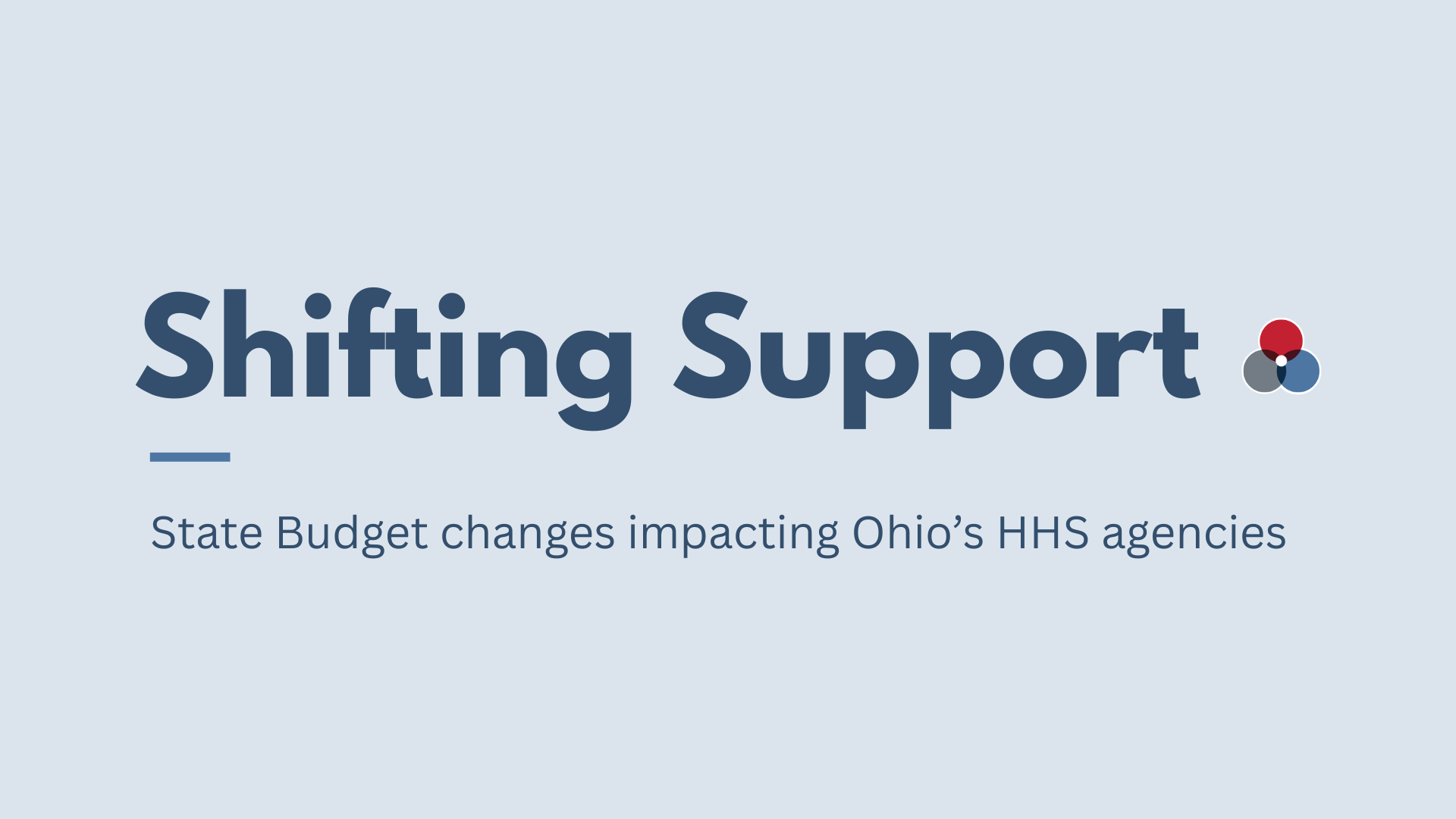By Karen Thompson-Shaheen and Jeanine Gergel, the Woodruff FoundationThe Woodruff Foundation was established in 1986 to enhance the development and delivery of mental health services in Cuyahoga County. Currently, the Foundation’s grant making prioritizes efforts that improve collaboration among agencies or between systems and/or that integrate behavioral health with primary care. This report was prepared by foundation staff and provides insights that can be useful to local and state policy makers and behavioral health providers. The Center for Community Solutions President and Executive Director John Corlett serves as member of the Board of Trustees of the Woodruff Foundation.
Introduction
After Ohio’s behavioral health redesign went into effect on January 1, 2018, the Woodruff Foundation (The Foundation) issued a survey to local providers to learn how they were faring under new rules and understand specific challenges they were facing. Across all agencies – regardless of size, services rendered or budget – workforce was cited as one of the sector’s largest collective problems. The Woodruff Foundation spent much of 2018 learning more about challenges to the behavioral health workforce locally, across the state and nationally, and also sought out best practices to inform an approach to assist local agencies.
Across all agencies – regardless of size, services rendered or budget – workforce was cited as one of the sector’s largest collective problems.
On January 22, 2019, the Foundation launched a second survey to community behavioral health providers to get baseline workforce information from Cuyahoga County providers. This survey sought to discover the number and types of providers agencies employed, the services those providers render, compensation levels for these providers and the supply and demand for each provider type. The survey, which was sent to 44 agencies that provide community-based behavioral health services, was active between January 22 and March 1, 2019. Twenty-eight agencies responded, representing a 64 percent response rate, including four agencies who filled out the survey without indicating an agency’s name. Agencies that completed surveys included:
Key Findings:
- The positions for which there is currently the greatest demand require either a master’s or bachelor’s degree (qualified mental health specialists (QMHS), licensed independent (LISW) and licensed social workers (LSW), licensed professional clinical counselor (LPCC) and licensed professional counselor (LPC)).
- The providers that are the most difficult to recruit and retain are LISWs (67 percent of respondents), psychiatrists (41 percent of respondents), LSWs (30 percent of respondents), and LPCC-S and licensed independent chemical dependency counselors (LICDC – each with 22 percent of respondents).
- Respondents cited inability to compete with compensation packages offered by other organizations (78%) and insufficient supply of qualified candidates (74%) as the top barriers to hiring their most difficult to recruit positions. Other barriers included lack of interest in community-based behavioral health (44%), emotional toll of the work (22%), productivity demands (22%), work hours (22%) and safety concerns (15%).
- Retention challenges cited by agencies included inability to compete with compensation packages of other organizations (89%), the emotional toll of the work (52%), productivity demands (33%), work hours (19%) and safety concerns. Retirement of current workers was cited as a challenge by one agency, and another voiced concerns that staff generally needed a full year of supervision and support to feel comfortable in their roles.
- Agencies were split in their opinions on how the behavioral health redesign impacted their ability to recruit workers, with 48% stating it was more difficult and 52% indicating it has made no difference. Those who indicated they have had increased difficulty hiring candidates cited competition with managed care organizations and the reimbursement rates versus the cost of licensure as challenges.
- Hospitals (50%), managed care organizations (30%) and private practice (39%) were the top destinations for workers leaving community-based behavioral health agencies. Others indicated their workers went to agencies not engaged in behavioral healthcare (31%), and some left the field entirely (27%).
Agencies indicated that the Woodruff Foundation could be most supportive around the workforce issue by:
- Engaging in advocacy work relating to reimbursement rates, licensing and credentialing requirements
- Providing resources for training new hires/offsetting productivity losses
- Providing salary enhancements or other incentives for retaining staff (e.g., tuition reimbursement, loan repayment, signing bonuses)
- Funding technology to decrease the administrative burden of credentialing
- Supporting paid internship positions apprenticeships for difficult-to-recruit providers
- Assisting agencies in collaborating on hires/job sharing
- Providing/supporting training for self-care for staff to reduce caregiver burnout
- Hosting a forum for community behavioral health agencies to discuss methods to attract and retain professionals.
Generally, agencies bemoaned the lack of adequate reimbursement rates that both allow them to recruit and retain a workforce that is able to provide that high-level, quality care that meets the needs of the very difficult population they serve.
Methodology
The survey was conducted via Survey Monkey and consisted of 152 questions. Each provider was asked to select the type of providers they employ, and, based on these responses, answer several questions relating to each provider type. These provider-specific questions were designed to understand which services each provider type rendered, the total number of the provider type employed, number of current vacancies, compensation levels and the optimal number of provider types. The optimal number for this survey’s purposes was defined as the number of particular types of provider each agency would ideally employ to meet current service demands; therefore, results typically do not tally to number currently employed plus the number of any vacancies. However, if an agency did not list any vacancies or a specific optimal number, the assumption made was that the current number of employed providers was that agency’s optimal staff level.
This survey sought to discover the number and types of providers agencies employed, the services those providers render, compensation levels for these providers and the supply and demand for each provider type.
Findings
Table 1 illustrates the provider types that were the focus of the survey, as well as the employment statistics and levels of compensation for each provider type. The providers for which there was the biggest gap between current and optimal staffing were licensed personnel that required a bachelor’s degree or higher level of education attainment (Figures 1 and 2).Figure 1

Figure 2

Table 1 – Employment data for behavioral health provider typesTying closely to the results of the gap analysis of current versus optimal positions, agencies indicated that LISWs, LSWs and psychiatrists were the top 3 most difficult positions to recruit. Others are illustrated in Figure 3.Figure 3: Percentage of agencies indicating top three most difficult-to-hire roles

Figure 4: Hiring and retention challenges, by agency response percentage

In Figure 4, “Other” responses included finding providers with the required amount of experience and a requirement that staff use their own vehicles to transport clients.
Figure 5: Destination of workers leaving agencies, by percentage of agency response

In Figure 5, “Other” responses included government agencies, other community behavioral health providers, retirement and office jobs with stable hours.
Implications for the Woodruff Foundation
Although qualitative data obtained through conversations/interviews with stakeholders including community college and ADAMHS Board representatives previously suggested that the Woodruff Foundation might consider funding the development of certificate programs that might boost the entry-level behavioral health workforce, the survey findings showing that the greatest workforce shortage exists in master’s-level providers suggest that investments in building capacity below the level of licensed provider will not materially alleviate the most pressing staffing challenges faced by behavioral health providers.
The barriers preventing more workers from pursuing the level of education required to fill these positions—and inhibiting agencies from retaining trained staff—are systemic and include low compensation (due to low reimbursement rates for services provided), a low (or negative) ROI on the cost of necessary education, and challenging working conditions.
The barriers preventing more workers from pursuing the level of education required to fill these positions—and inhibiting agencies from retaining trained staff—are systemic and include low compensation (due to low reimbursement rates for services provided), a low (or negative) ROI on the cost of necessary education, and challenging working conditions. If Trustees wish to have more than a limited or one-off impact, addressing any of these barriers directly (e.g., through earmarking funds for salary enhancement, tuition reimbursement or loan repayment) may be beyond the grantmaking capacity of the Foundation given available resources.Staff suggests that proactive, state-level advocacy efforts relating to improving reimbursement rates, expanding reimbursable services and revising licensing/credentialing requirements may be where the greatest opportunity for systemic impact lies. We also believe that the role that local colleges and universities play in promoting behavioral health careers needs to be more fully explored to determine if there are opportunities for the Foundation to provide meaningful support in this area.








